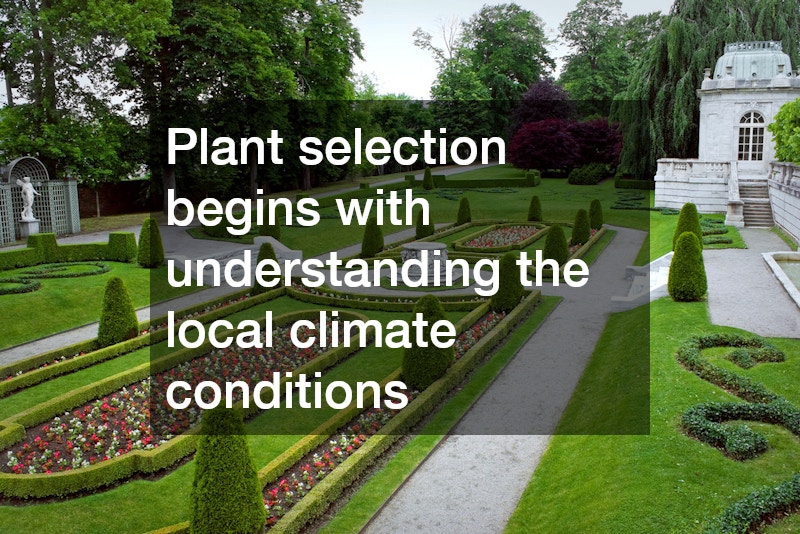Explore essential design tips shared by experts from a landscape contracting service, and find insights into creating beautiful and functional outdoor spaces.
Key Principles
Key elements such as unity, balance, and focal points play a significant role in landscape design. Understanding these principles helps in crafting a landscape that feels cohesive and inviting.
Experts often emphasize the importance of maintaining proportion and scale to ensure that each element complements the others, resulting in a well-designed outdoor space.
Another crucial principle is the use of color and texture, which adds depth and interest to the landscape. A successful design intertwines various hues and leaf patterns, making the space dynamic and visually appealing throughout the seasons. Implementing these aspects allows homeowners to create a landscape that reflects their personal style while maintaining harmony within the environment. This balanced approach ensures that all features work together, producing a tranquil and enjoyable outdoor experience.
Lastly, experts consistently advise on the importance of functionality in landscape design. The layout should not only look good but also serve the needs of its users. Functionality encompasses creating paths for movement, designated areas for relaxation or entertainment, and ensuring that practical elements like drainage are adequately considered. This harmonious blend of beauty and utility is the hallmark of expert landscape design.
Plant Selection
Plant selection begins with understanding the local climate conditions, including temperature, rainfall, and sunlight exposure. When homeowners align their choices with their environment, they set the foundation for a thriving garden. Moreover, experts recommend considering seasonal changes as this affects plant performance over time, helping to create an attractive landscape in every season.
Understanding soil characteristics is equally critical in making informed plant choices. Soil type, pH level, and drainage properties influence which plants will thrive in a specific area. Landscape professionals often advocate for soil testing to determine the right amendments needed to support healthy plant growth. This informed approach ensures that the selected plants will not only survive but also flourish, enhancing the overall aesthetics of the landscape over the long term.
Additionally, it’s essential to consider the overall landscape goals, whether they involve creating a serene retreat, a vibrant garden, or a low-maintenance environment. Each plant species has unique requirements and attributes, meaning that careful selection can significantly impact maintenance levels and ecological sustainability. Landscape experts often suggest combining native and drought-resistant plants for a beautiful yet sustainable garden that adapts well to local conditions.
Outdoor Lighting
Well-designed outdoor lighting not only illuminates pathways but also emphasizes architectural features and landscaping elements. Lighting can create moods, highlight focal points, and provide safety in outdoor areas. Therefore, it is recommended to plan the lighting layout early in the design process to ensure a cohesive approach.
Experts suggest a layered lighting strategy that incorporates ambient, task, and accent lighting. Ambient lighting provides general illumination, creating a warm atmosphere; task lighting focuses on specific areas like seating or cooking spaces, while accent lighting showcases plants, sculptures, and other features. Balancing these various light sources enhances the landscape’s functionality and aesthetic, allowing for enjoyable use during the evening hours.
Moreover, energy efficiency should be a primary consideration when selecting outdoor lighting. Experts encourage the use of LED fixtures and solar-powered lights, which not only reduce energy consumption but also provide longevity. The choice of lighting fixtures should reflect the overall design theme while ensuring the landscape remains eco-friendly and cost-effective over time, paving the way for attractive and sustainable outdoor spaces.
Hardscaping Elements
Hardscaping provides structure and organization to a landscape, creating defined spaces that enhance usability. Effective integration of hardscape elements contributes to the overall aesthetic, ensuring that they complement plant selections and architectural features. This balance is essential for a cohesive outdoor design.
When selecting materials for hardscaping, experts advise considering durability, maintenance, and environmental impact. Paving materials like stone, brick, or concrete must withstand weather conditions while harmonizing with the overall design theme. Color and texture also play significant roles in selecting hardscaping elements that enhance the visual appeal of the landscape, allowing for a cohesive transition between hard and soft elements.
Incorporating hardscaping can also provide practical benefits, such as erosion control, improved drainage, and increased property value. By carefully planning these features, homeowners can create functional outdoor spaces that invite social gatherings, relaxation, and enjoyment. As such, hardscaping serves as a backbone to a well-designed landscape that maintains both beauty and utility.
Maintenance Tips
Regular maintenance is crucial for sustaining the beauty and health of any landscape, which includes tasks like pruning, watering, and fertilizing. Experts often advise homeowners to create a seasonal maintenance schedule that outlines which tasks need to be done, ensuring a systematic approach to gardening care.
Mulching is another important practice that not only enhances the garden’s aesthetic but also helps retain moisture in the soil while suppressing weeds. Experts recommend using organic mulches as they gradually enrich the soil and promote healthy plant growth. This practice, combined with efficient watering techniques, allows for a balanced ecosystem within the landscape, promoting long-term sustainability.
Staying vigilant about pests and diseases is paramount for maintaining a vibrant landscape. Consistent observation can help identify potential issues before they escalate. Landscape professionals suggest adopting integrated pest management practices that prioritize eco-friendly solutions while addressing pest problems effectively. Adopting these maintenance tips can ensure a flourishing landscape that remains healthy and attractive year-round.
Applying these design tips from landscape contracting service experts can greatly enhance the beauty and functionality of your outdoor space, ensuring a thriving landscape for years to come.

